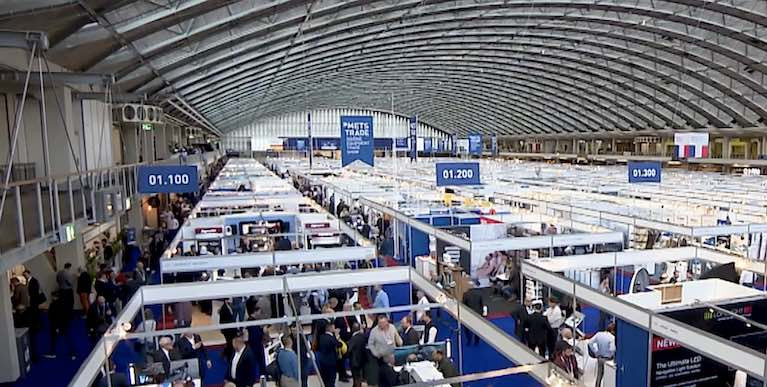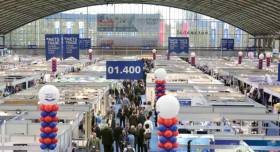Displaying items by tag: METSTRADE
MetsTrade Fair 2020 is Cancelled in Amsterdam
METSTRADE and RAI Amsterdam have announced that the world's largest marine equipment trade show, which was scheduled on 17-19 November in RAI Amsterdam, has been cancelled.
For more than 32 years, METSTRADE has been providing the most complete meeting place for the global marine industry. Due to the consequences of the COVID-19 outbreak, our mission cannot be accomplished successfully, therefore we believe it is the right decision to cancel this year’s show. METSTRADE 2021 will take place on 16-18 November 2021 in RAI Amsterdam.
RAI Amsterdam is ready to accommodate METSTRADE in a COVID19-secure way, fully in line with all health and safety guidelines. The RAI has worked tirelessly to adapt all its facilities and protocols to enable events to be held in a safe, responsible and hospitable manner. However, given the uncertain worldwide situation we believe we cannot guarantee the high-quality show in 2020 with valuable face-to-face contacts with visitors which is expected from METSTRADE.
Niels Klarenbeek, Director Maritime METSTRADE, is naturally disappointed, but also optimistic: "We have worked towards a safe and successful METSTRADE with great dedication. The cancellation of the METSTRADE 2020 show has been a tough blow for my team and I, but listening to the multiple voices in the industry including the Exhibition Committee, ICOMIA, partners and the stakeholders this is the only right decision we could make. Our team is working together with our partners on different virtual ways to connect the leisure marine industry in these tough times.”
ICOMIA members support the decision to cancel this year’s show and understand the current challenges. Sara Anghel, ICOMIA’s president “It has been an extremely tough decision and the COVID-19 pandemic has had a big impact on the industry. ICOMIA endorses the decision of RAI Amsterdam and will cooperate with the METSTRADE team to be the homeport of the industry as soon as possible.”
Bas Dalm, Executive Vice President Exhibition & Sales RAI Amsterdam is saddened by the decision to cancel the METSTRADE show: “RAI Amsterdam has been hit hard by the current global crisis. We have remained hopeful about the continuation of METSTRADE until the very end, but the global situation has not improved significantly. Although this decision hurts the entire leisure marine industry, it is the only right decision at this given moment.”
Wins for Spirit & Princess at IBI-METSTRADE Boat Builder Awards 2019
British Marine members, Spirit Yachts and Princess Yachts, had a fantastic night at the IBI-METSTRADE Boat Builder Awards 2019, which took place on Tuesday (19 November) at the National Maritime Museum in Amsterdam.
Spirit Yachts’ innovative manufacturing process and yacht designs saw it awarded the best ‘Environmental Initiative’ of 2019. Having just launched its largest-ever sailing yacht, the electric drive, 34m Spirit 111, Spirit looks to set a new standard in eco yachts.
As explained by Nigel Stuart, Managing Director at Spirit Yachts, he commented: “The award is fantastic recognition for the team’s dedication to continually improving Spirit Yachts’ environmental footprint. We work incredibly hard to innovate in-house, collaborate with suppliers and invest in research to reduce the eco-impact of our yachts in build, on the water and at the end of life. In order to meet global environmental targets, the industry must work together and share insight to create a sustainable future.”
Princess Yachts’ apprenticeship scheme and leadership pathways received the Best Apprenticeship and Trainee Scheme award. This follows Princess’ announcement earlier this year that it is more than doubling the number of apprentices it welcomes to its ranks. Apprentices will receive what’s described as an immersive experience of all operations over their four-year traineeship, authentically replicating the assembly line, right down to the scheduled ‘buzzer’ break times.
Remarking at the time, Paul Turner, HR Director at Princess Yachts, said: “Princess Yachts has always believed in inspiring people to achieve their best, investing heavily in its yearly apprenticeship scheme. The doubling of the intake for 2019 is not only a commitment to shaping the workforce of tomorrow, but validation of Princess Yacht’s robustness after an outstanding two years of growth. We are proud of the fact that virtually all apprentices move into permanent employment with Princess following the conclusion of their four-year courses.”
Lesley Robinson, CEO at British Marine, commented on the night’s successes: “These richly deserved awards show how strong British boatbuilding is. We are proud of both Spirit Yachts and Princess Yachts and their teams who help ensure the UK remains at the forefront of tackling some of the biggest challenges facing our industry. In this case, both reducing our environmental impact and bridging the sector’s skills gap.”
This has been a great week for British Marine members at METSTRADE with an additional ten companies receiving accolades at the DAME Design Award 2019 during a ceremony on Tuesday morning.
British Marine is at the Show, hosting and organising the British Pavilion, and supporting the 155 British companies exhibiting across the event.
METSTRADE Show Attracts Record-Breaking International Audience
The annual METSTRADE Show in Holland has completed a very successful week, reinforcing its reputation as the world’s premier gathering of the leisure marine community. As well as breaking new ground in terms of exhibitor and visitor numbers, the B2B event in RAI Amsterdam convention centre welcomed an exceptional 116 different nationalities, the highest number to date. With some 10,500 visitors coming from outside the Netherlands, six percent more than in 2016, the METSTRADE Show has an unrivalled international character. METSTRADE 2018 will take place from 13 to 15 November.
As the 30th birthday edition of this platform for leisure marine professionals, METSTRADE 2017 was always destined to be a special event. Early indications are that visitor figures were the highest recorded for the three-day event, with 16,307unique visitors (an increase of over 5% compared to 2016) and an overall total of 24,856 visits (also plus 5%). Even more pleasing to the organisers, who are committed to ensuring that the METSTRADE Show remains the essential global meeting place for the leisure marine industry, was that these visitors came from 116 different countries (107 in 2016).
Growth across the board
An impressive 68% of all new visitors came from outside the Netherlands, with the top five visitor countries (after NL) being Italy, the United Kingdom, Germany, France and Spain. Significant growth was seen from Greece, Croatia, Finland, the United States and Ireland. All visitors were welcomed on the show floor by no less than 1552 exhibitors (a rise of 5% compared to last year), whose stands were manned by around 6594 high-end industry professionals. The exhibiting companies were also delighted by the unprecedented international flavour of the event.
“METSTRADE continues to be an important platform for our brand to meet with many of our distributors from around the world, including New Zealand, Canada, South Africa and Singapore,” comments Chris Feibusch, Head of Global Marketing for WesCom Signal and Rescue in the UK. “This was the first time that we have exhibited under our new name following a rebrand last month and it was great to reconnect and discuss business with current and prospective distributors at METSTRADE. We look forward to following these business leads up.”
Atul Gupta, director of the Indian company Multiflex Marine, was equally enthusiastic. “METSTRADE is the Mecca of the marine industry and by far the best show of its kind anywhere in the world. We exhibit at many exhibitions worldwide but nothing beats METSTRADE. Having attended the event over the last eight years we have pretty much built all our international business via the METSTRADE Show.”
Vibrant and innovative
While the facts & figures make good reading for the METSTRADE team, what also matters is the way the show was perceived by all who attended. “This anniversary edition was a success because it was conducted in a vibrant atmosphere where exhibitors and visitors alike enjoyed excellent business,” comments RAI Amsterdam’s Maritime Director Irene Dros. “There was also a great deal of appreciation for the exceptionally high number of new and innovative products on display. The newly introduced E-nnovationLAB added to this, featuring technologies and manufacturers of electric & hybrid marine propulsion systems. The foundations have been laid for a promising showcase which will evolve in the years ahead.”
Future-proof
Another future-oriented theme at METSTRADE 2017 was the way younger people were placed firmly in the spotlight, with the large number in attendance adding to the inspiring mood. The METSTRADE Young Professionals Club lounge was very busy and the first edition of the YPC canal cruise was a great success, with the IBEX Millennials joining the fun.
“We have a clear ambition for METSTRADE to embrace the next generation of both people and technologies,” explains Dros. “To thrive in the future, the marine industry must strengthen partnerships, focus on the latest developments in society, and use the latest propulsion and production methods. We believe in stepping into the world which connects the I-pad & game generation – the vloggers and other young influencers who have an enormous impact on consumer behaviour and their followers’ aspirations for luxury products such as boats.”
































































